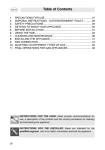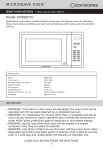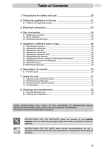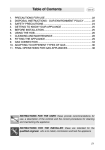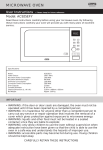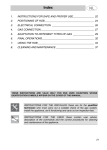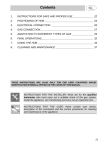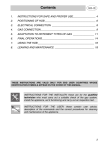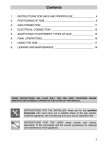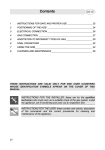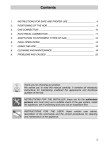Download Smeg PDX30T-1 hob
Transcript
Table of Contents 1. 2. 3. 4. 5. 6. 7. 8. 9. 10. 11. PRECAUTIONS FOR USE ..................................................................28 DISPOSAL INSTRUCTIONS - OUR ENVIRONMENT POLICY ..........29 SAFETY PRECAUTIONS ....................................................................30 GETTING TO KNOW YOUR APPLIANCE ..........................................31 BEFORE INSTALLATION....................................................................32 USING THE HOB.................................................................................33 CLEANING AND MAINTENANCE .......................................................39 INSTALLING THE APPLIANCE...........................................................42 GAS CONNECTION ............................................................................45 ADAPTING TO DIFFERENT TYPES OF GAS ....................................47 FINAL OPERATIONS FOR GAS APPLIANCES..................................49 INSTRUCTIONS FOR THE USER: these provide recommendations for use, a description of the controls and the correct procedures for cleaning and maintaining the appliance INSTRUCTIONS FOR THE INSTALLER: these are intended for the qualified engineer who is to install, commission and test the appliance 27 Precautions for Use 1. PRECAUTIONS FOR USE THIS MANUAL IS AN INTEGRAL PART OF THE APPLIANCE. TAKE GOOD CARE OF IT AND KEEP IT TO HAND THROUGHOUT THE HOB'S LIFE CYCLE. WE URGE YOU TO READ THIS MANUAL AND ALL THE INFORMATION IT CONTAINS CAREFULLY BEFORE USING THE APPLIANCE. INSTALLATION MUST BE CARRIED OUT BY QUALIFIED STAFF IN COMPLIANCE WITH THE RELEVANT REGULATIONS. THIS APPLIANCE IS INTENDED FOR HOUSEHOLD USE AND COMPLIES WITH THE EEC DIRECTIVES CURRENTLY IN FORCE. THE APPLIANCE IS BUILT TO PROVIDE THE FOLLOWING FUNCTION: COOKING AND HEATING FOODS; ALL OTHER USES ARE TO BE CONSIDERED IMPROPER. THE MANUFACTURER DECLINES ALL LIABILITY FOR USES OTHER THAN THOSE STATED ABOVE. NEVER USE THIS APPLIANCE FOR HEATING ROOMS. NEVER USE PACKAGING RESIDUES UNATTENDED IN THE HOME. SEPARATE THE VARIOUS WASTE PACKAGING MATERIALS BY TYPE AND CONSIGN THEM TO THE NEAREST SEPARATE DISPOSAL CENTRE. THIS APPLIANCE IS MARKED ACCORDING TO THE EUROPEAN DIRECTIVE 2002/96/EC ON WASTE ELECTRICAL AND ELECTRONIC EQUIPMENT (WEEE). THIS GUIDELINE IS THE FRAME OF A EUROPEAN-WIDE VALIDITY OF RETURN AND RECYCLING ON WASTE ELECTRICAL AND ELECTRONIC EQUIPMENT. NEVER OBSTRUCT THE OPENINGS VENTILATION AND HEAT DISPERSAL. AND SLITS PROVIDED FOR THE NAMEPLATE WITH THE TECHNICAL DATA, SERIAL NUMBER AND MARK ARE IN A VISIBLE POSITION UNDERNEATH THE CASING. THE NAMEPLATE MUST NEVER BE REMOVED. (FOR THE CERAMIC MODELS ONLY) TAKE CARE NOT TO SPILL SUGAR OR SWEET MIXTURES ONTO THE HOB DURING COOKING, OR TO PLACE MATERIALS OR SUBSTANCES WHICH MIGHT MELT (PLASTIC OR ALUMINIUM FOIL) ON IT; IF THIS SHOULD OCCUR, TO AVOID DAMAGE TO THE SURFACE, TURN THE HEATING OFF IMMEDIATELY AND CLEAN WITH THE SCRAPER SUPPLIED WHILE THE COOKING ZONE IS STILL WARM. IF THE CERAMIC HOB IS NOT CLEANED IMMEDIATELY, RESIDUES MAY FORM WHICH CANNOT BE REMOVED ONCE THE HOB HAS COOLED. 28 Disposal instructions 2. DISPOSAL INSTRUCTIONS ENVIRONMENT POLICY - OUR Our products are only packaged using non-pollutant, environment-friendly, recyclable materials. We urge you to cooperate by disposing of the packaging properly. Contact your local dealer or the competent local organisations for the addresses of collection, recycling and disposal facilities. Never leave all or part of the packaging lying around. Packaging parts, and especially plastic bags, may represent a suffocation hazard for children. Your old appliance must also be disposed of properly. Important: deliver the appliance to your local organisation authorised to collect scrapped appliances. Proper disposal allows the intelligent recovery of valuable materials. Cut the power supply lead and remove it and the plug. 29 Safety Precautions 3. SAFETY PRECAUTIONS SEE INSTALLATION INSTRUCTIONS FOR SAFETY REGULATIONS FOR ELECTRIC OR GAS APPLIANCES AND FOR VENTILATION FUNCTIONS. IN YOUR INTEREST AND TO ENSURE YOUR SAFETY, BY LAW ALL ELECTRIC APPLIANCES MUST ONLY BE INSTALLED AND SERVICED BY QUALIFIED STAFF, IN ACCORDANCE WITH THE RELEVANT REGULATIONS. OUR APPROVED INSTALLATION ENGINEERS GUARANTEE YOU A JOB WELL DONE. GAS OR ELECTRIC APPLIANCES MUST ALWAYS BE DISCONNECTED BY SUITABLY SKILLED PEOPLE. THE PLUG TO BE CONNECTED TO THE POWER SUPPLY LEAD AND THE RELATIVE SOCKET MUST BE OF THE SAME TYPE AND COMPLY WITH THE RELEVANT REGULATIONS. THE POWER SUPPLY SOCKET MUST BE ACCESSIBLE EVEN AFTER THE APPLIANCE HAS BEEN BUILT-IN. NEVER DISCONNECT THE PLUG BY PULLING ON THE POWER SUPPLY LEAD. THE APPLIANCE MUST BE CONNECTED TO EARTH IN COMPLIANCE WITH ELECTRICAL SYSTEM SAFETY REGULATIONS. IMMEDIATELY AFTER INSTALLATION, CARRY OUT A QUICK TEST ON THE APPLIANCE FOLLOWING THE INSTRUCTIONS PROVIDED LATER IN THIS MANUAL. IF THE APPLIANCE FAILS TO OPERATE, DISCONNECT IT FROM THE ELECTRICAL MAINS AND CONTACT YOUR NEAREST SERVICE CENTRE. NEVER ATTEMPT TO REPAIR THE APPLIANCE. THE APPLIANCE BECOMES VERY HOT DURING USE. OVEN GLOVES SHOULD ALWAYS BE WORN. THE APPLIANCE IS INTENDED FOR USE BY ADULTS. KEEP CHILDREN AT A SAFE DISTANCE AND NEVER ALLOW THEM TO PLAY WITH IT. AFTER EACH USE, ALWAYS CHECK THAT THE CONTROL KNOBS ARE TURNED TO 0 (OFF). IF YOU NOTICE ANY CRACKS OR DAMAGE TO THE SURFACE OF THE GLASS CERAMIC HOTPLATE, IMMEDIATELY DISCONNECT THE APPLIANCE FROM THE POWER SUPPLY AND CONTACT AN AUTHORIZED AFTER-SALES SERVICE CENTRE. The manufacturer declines all responsibility for injury or damage caused by failure to comply with the above regulations or deriving from tampering with even just one part of the appliance and the use of non-original spare parts. 30 Instructions for the User 4. GETTING TO KNOW YOUR APPLIANCE Auxiliary Burner (AUX) Semi-rapid (SR) burner Small cooking zone Rapid Burner (R) Barbeque heating element Heating element safety device Heating element Ultrarapid Burner (UR3) Ultrarapid Burner (UR3) Raised spoke pan stand Large cooking zone Residual heat warning lights Barbeque heating element thermostat light Green power on light Frier red thermostat light 31 Instructions for the User 5. BEFORE INSTALLATION Never leave packaging residues unattended in the home. Separate waste packaging materials by type and consign them to the nearest separate disposal centre. The inside of the appliance should be cleaned to remove all manufacturing residues. For further information about cleaning, see chapter "7. CLEANING AND MAINTENANCE". When the electric plates or barbecue (when fitted) are used for the first time, they should be heated to the maximum temperature for long enough to burn off any oily residues left by the manufacturing process, which might contaminate foods with unpleasant smells. 32 Instructions for the User 6. USING THE HOB 6.1 Gas hob Before lighting the hob burners check that the flame diffuser rings are correctly in place with their respective burner caps, making sure that the holes A in the flame diffusers are aligned with the plugs and thermocouples. The optional grid B is for use with woks. To prevent damage to the hob, the appliance comes complete with a raised grid C. This grid is intended for use underneath pans which exceed the diameter stated in the table in point "6.3 Pan diameters". All pans more than 30 cm in diameter must only be used on the central burner. The burner it controls is shown next to each knob. The appliance is equipped with an electronic ignition device. Simply press the knob and turn it anticlockwise to the maximum flame symbol, until the burner lights. If it does not light within the first 15 seconds, turn the knob to 0 and wait at least 60 seconds before trying to light the burner again. On models equipped with valves, once the burner has ignited, keep the knob pressed down for a few seconds to allow the thermocouple to heat up. The burner may go out when the knob is released: in this case, the thermocouple has not heated up sufficiently. Wait a few moments and repeat the operation, keeping the knob pressed down for longer. This is not necessary on burners not equipped with thermocouple. Once the burner has been ignited, the flame can be regulated as required. After each use of the hob, always check that the control knobs are turned to (off). If the burners should go out accidentally a safety device will be tripped about 20 seconds later, cutting off the gas supply even if the gas tap is open. In this case, turn the knob back to the off position and wait at least 60 seconds before trying to relight the burner. 33 Instructions for the User 6.2 Practical hints for using the burners For better burner efficiency and to minimise gas consumption, use pans with flat, even bottoms with lid and of suitable size for the burner, so that flames do not reach up the sides of the pan (see point "6.3 Pan diameters"). Once the contents come to the boil, turn down the flame far enough to prevent the liquid from boiling over. When cooking, to prevent burns or damage to the hob all pans or griddle plates must be placed inside the perimeter of the hob. Take the greatest care when using fats or oils since they may catch fire if overheated. 6.3 Pan diameters BURNERS 1 2 3 4 5 6 Auxiliary Semi rapid Rapid Ultra rapid Ultra-rapid with raised spoke pan stand Fish Ø MIN. AND MAX. (IN CM) 12 - 16 16 - 24 18 - 26 20 - 26 20 - 31 SPECIAL OVAL PANS See below for the diameters of the pans which can be used with the raised pan stand: BURNERS Ø MIN. AND MAX. (IN CM) 1 2 3 34 Auxiliary Semi rapid Rapid 16 - 24 24 - 28 26 - 28 Instructions for the User 6.4 Ceramic hob The appliance is equipped with two cooking zones having different diameters and powers. Their positions are clearly marked by rings and heating only occurs inside the diameters marked on the hob. The cooking zones switch on after a few seconds and their temperature is regulated by turning the knob to the required setting between 1 and 9. Setting is on a gradual scale, so all the intermediate positions between the numbers can be used. The lights beside the knobs are residual heat warning lights. They come on when the cooking zone temperature exceeds 50° C and go out when it falls below this value. For cleaning instructions, see point “7.3 Cleaning the ceramic hob”. 6.4.1 Recommended cooking tables The table below shows the power values which can be set, with the relative type of food alongside. The values may vary depending on the amount of food and personal taste. Knob setting Recommended cooking operation Melting butter, chocolate, etc. 1 Heating foods, keeping small amounts of water on the boil, beating egg-yolk or butter sauces. Heating solid and liquid foods, keeping water on the boil, 4-5 defrosting frozen foods, 2-3 egg omelettes, fruit and vegetable dishes, various cooking operations. Braising meat, fish and vegetables, dishes containing 6 some water, making jams, etc. Roasting meat or fish, steaks, liver, browning meat and 7-8 fish, eggs, etc. Deep-fat frying potatoes etc., bringing water to the boil 9 quickly. For efficient operation without wasting energy, only pans suitable for cooking on electric appliances must be used: 2-3 35 Instructions for the User • • • 6.5 Pan bottoms must be very thick and perfectly flat, and they and the hob must be clean and dry. Never use cast iron or rough-bottomed pans since they might scratch the cooking surface. The diameter of the pan bottom must be the same as the diameter of the ring on the cooking zone; otherwise, energy will be wasted. Barbeque You can use the barbeque section for grilling, gratiné dishes or as a barbeque. The tank underneath the heating element can be filled with: • water (Fig. 1) to collect cooking fat and grease (do not place more than one and a half litres of water in the tank), or; 1) • a layer of lava rock which retains the heat for longer, improving cooking times and quality. In both cases, do not fill above the rim of the basin. Before pouring water or lava rock into the tank, 2) secure the heating element as shown in fig. 2. WARNING: when raised, the movable heating element must always be locked in position with the sliding fixture provided. WARNING: before raising the heating element, make sure it is cold. Risk of burns! WARNING: when the heating element is raised, take care not to turn on the control device. Risk of burns! The barbeque heat level is regulated using the control knob, turning it to the setting required between 1 and 9. Setting is on a gradual scale, so all the intermediate positions between the numbers can be used. The light comes on to indicate that the barbeque is heating up. This light goes out when the set power level is reached. 36 Instructions for the User When it flashes at regular intervals, the barbeque power level is being kept constantly at the set level. For grill removal and cleaning instructions, see point “7.4 Cleaning the barbeque”. 6.6 Frier The frying temperature is selected by turning the knob to a setting between 1, 2 and 3. The following table summarises the type of frying operation suitable for the various settings. The green light comes on to indicate that the appliance is powered up (even when it is not in operation). The orange light comes on to indicate that the heating element is heating up. This light goes out when the set power level is reached. When it flashes at regular intervals, the barbeque power level is being kept constantly at the set level. The table below shows the power values which can be set, with the relative type of food alongside. The values may vary depending on the amount of food and personal taste. Knob setting Ideal Maximum Recommended cooking operation quantity quantity (gr.) (gr.) 1 (160° C) Chips Chicken Legs - Wings 1-2 (170° C) Fried fish 2 (180° C) Fritters - Fish 500 750 * * * * 250 350 2-3 (185° C) Potato croquettes - Cheese croquettes 500 750 * = these values basically depend on the volume of food. Take care that food is completely submerged in the oil. 6.6.1 Practical advice for succesful frying The oil level in the well must always be between 3 litres (minimum level marked inside the well) and 3.5 litres (maximum level marked inside the well). The heating element must always be submerged in oil or fat before it can operate. Never place solid animal or vegetable fat in the well. It must be melted before it is placed in the frying well. 37 Instructions for the User WARNING: before raising the heating element, make sure it is cold. Risk of burns! WARNING: when the heating element is raised, take care not to turn on the control device. Risk of burns! The ideal frying temperature is between 160° C adn 185° C. At higher or lower values, the oil deteriorates very quickly. If the temperature is too low, the food's surface is not sealed by the heat and it becomes greasy. The larger the pieces, the longer they need to fry. It is therefore important to set a temperature that will cook the food in depth without burning it on the outside. 6.6.2 When you finish frying The basket containing the fried food can be left to drain before its contents are poured out. To do this, hang it on the hooks provided in the top of the heating element as shown on the right. Once the basket has been removed, the heating element can be fixed in two positions using its special retainer: 1 position 1 to drain the frying oil before it is raised completely; 2 position 2, which allows convenient removal of the tank. See point "7.5 Cleaning the frier". 1) 2) WARNING: before removing the oil from the tank, make sure that it is cold. Risk of burns! Keep children at a safe distance. 38 Instructions for the User 7. CLEANING AND MAINTENANCE NEVER USE A JET OF STEAM FOR CLEANING THE APPLIANCE. Before carrying out any operations, disconnect the appliance from the electricity supply. 7.1 Cleaning stainless steel To keep stainless steel in good condition, it must be cleaned regularly, after each use of the appliance, first allowing it to cool. 7.1.1 Routine daily cleaning When cleaning and caring for stainless steel surfaces, always use only specific products which do not contain abrasives or chlorine-based acids. Instructions for use: pour the product onto a damp cloth and wipe over the surface, then rinse thoroughly and dry with a soft cloth or chamois leather. 7.1.2 Food stains or spills Never use metal scouring pads or sharp scrapers; they will damage surfaces. Use ordinary non-abrasive products for steel, with the aid of wooden or plastic utensils if necessary. Rinse thoroughly and dry with a soft cloth or chamois leather. 7.2 Cleaning the gas components The grids, the burner caps, the flame diffuser rings and the burners can be removed for easier cleaning; wash them in hot water and non-abrasive detergent, taking care to remove all deposits, and wait for them to dry completely. Replace the burner caps on their rings, making sure that the holes A are perfectly centered with the circular projections B on the burners. For best performance, the ignition plugs and thermocouples must always be kept thoroughly clean. Check them frequently and if necessary clean them with a wet cloth. Remove any dry residues with a wooden toothpick or a needle. 39 Instructions for the User 7.3 Cleaning the ceramic hob The ceramic hob must be cleaned regularly, preferably after each use, when the residual heat warning lights have gone out. Any marks left by the use of pans with aluminium bottoms can be wiped off with a cloth dipped in vinegar. If burnt residues are left after cooking, remove them with the scraper provided, rinse with water and dry thoroughly with a clean cloth. Regular use of the scraper considerably reduces the use of chemicals for daily cleaning of the hob. In any case, abrasive or corrosive cleaners (e.g. powder products, oven-cleaner sprays, stain removers and metal scouring pads) must never be used. Never use a jet of steam for cleaning the appliance. 7.4 Cleaning the barbeque After leaving it to cool, remove the barbeque plate by lifting it from the front as shown in figure 1. Clean it with an ordinary detergent and a non- 1) abrasive sponge. To remove the tank underneath the barbeque heating element: 1 Remove the plate as described; 2 Lift the heating element and secure it by sliding the retainer to the right (as shown in figure 2/3); 3 Remove the tank using the two handles and clean it with a specific stainless steel detergent 2) and non-abrasive sponge. 3) WARNING: before raising the heating element, make sure it is cold. Risk of burns! 40 Instructions for the User WARNING: when the heating element is raised, take care not to turn on the control device. Risk of burns! 7.5 Cleaning the frier Apart from following the instructions provided in point “7.1 Cleaning stainless steel”, a few precautions are necessary when cleaning the well. Once you have finished frying and removed the basket (which is dishwasher-friendly), use the handles provided to lift out the well containing the frying oil. BEFORE DOING THIS, ALLOW THE TANK AND THE OIL IT CONTAINS TO COOL. KEEP CHILDREN AT A SAFE DISTANCE. After all the frying oil has been disposed of appropriately, the tank and the basket can both be washed in a dishwasher. WARNING: before raising the heating element, make sure it is cold. Risk of burns! WARNING: when the heating element is raised, take care not to turn on the control device. Risk of burns! 41 Instructions for the Installer 8. INSTALLING THE APPLIANCE 8.1 Fitting the appliance in the top This appliance is in class 3. The procedures required below must be carried out by a skilled builder and/or joiner. The hob can be installed on various materials, including masonry, metal, solid wood and wood finished with plastic laminates, provided the material is heat-resistant (T 90° C). 8.1.1 Fixing to the supporting structure To install the appliance the opening “B” and the holes “A” shown in figure 1 must be made in the top; see figure 2 for the relative dimensions and distances. The foam rubber strip “C” (Fig. 1) is supplied with the appliance, and must be fixed with its adhesive side facing towards the supporting surface. The area inside the dotted line marks the external dimensions of your appliance. Make sure that there is at least 750 mm between the hob burners and any shelving placed vertically above them (Fig. 3). If the top is more than 20 mm thick, the hole required to install the hob is shown in figure 4. 1) 2) The distance “Y” is the difference between the total thickness of the top and the depth of the hole ø7, which is always 20 mm. 3) 42 4) Instructions for the Installer WARNING: IF YOU ARE INSTALLING A HOB WITH FISH BURNER, THE DISTANCE "X" FROM THE SIDE WALL INCREASES FROM 100 mm TO 300 mm. See side for the hole to be made in the top if the frier is to be installed. The dotted lines show the external dimensions of the product, and the grey area the size of the hole. Important: other types of installation are only possible under the manufacturer's supervision. 8.2 Electrical connection Check that the power supply voltage and size are as specified on the nameplate below the appliance carter. The nameplate must never be removed. The appliance must be connected to earth in compliance with electrical system safety regulations. If a permanent connection is used, the appliance's power supply line must be fitted with an omnipolar breaking device with contact gap of at least 3 mm, located in an easily accessible position close to the appliance itself. If a socket and plug connection is used, check that they are of the same type. Do not use reducers, adapters or junctions since they may cause overheating or burns. 43 Instructions for the Installer Operation at 220-240 V~: use a type H05V2V2-F three-wire cable (cable of 3 x 1.5 mm2 for electric hobs and a cable of 3 x 0.75 mm2 for gas hobs) The earth wire (yellow-green) must be at least 20 mm longer than the other wires at the end for connection to the appliance. The manufacturer declines all responsibility for injury or damage caused by failure to comply with the above regulations or deriving from tampering with even just one part of the appliance. 44 Instructions for the Installer 9. GAS CONNECTION Before installing it, check that the local gas supply conditions (gas type and pressure) are compatible with the appliance's settings. The connection to the gas mains may be made using a copper pipe or a continuous-wall steel hose in accordance with the standard regulations in force. When installation is complete, check for any leaks with a soapy solution, never with a naked light. The appliance is tested with G20 (2H) natural gas at the pressure of 20 mbar. For use with other types of gas, see point "10. ADAPTING TO DIFFERENT TYPES OF GAS". The gas intake connection has an external ½” gas thread (ISO 228-1). Connection with copper pipe: The connection to the gas supply mains must be made so that no stresses or strains of any kind are applied to the appliance. The connection can be made using the adapter unit D with two conical elemetns, always fitting the gasket C supplied. Connection with steel hose: Use only continuous-wall stainless steel hoses compliant with the relevant regulations, and always fit the gasket C supplied between the fitting A and the hose B. When connecting with a hose, ensure that the total length of the pipeline is not more than 1.5 metres; also ensure that the hoses do not touch moving parts and are not crushed. 9.1 Bottled gas connection Use a pressure regulator and make the connection to the gas cylinder in accordance with the relevant regulations. Make sure that the gas supply pressure is as stated in the table in point "10.2 Burner and Nozzle Data Tables". 45 Instructions for the Installer 9.2 Room ventilation The appliance may only be installed in a permanently ventilated room as specified by the relevant regulations. The air flow into the room where the appliance is installed must be sufficient for proper gas combustion and room ventilation. The air intakes, protected by gratings, must be of suitable size (see relevant regulations) and located so that they cannot be even partially obstructed. The kitchen must be kept properly ventilated to disperse the heat and humidity produced by cooking processes: in particular, a window should be opened or the speed of any fans increased after prolonged use. 9.3 Combustion gas discharge Combustion gases must be discharged by means of hoods connected to a flue with reliable natural draught, or a fan extraction system. An effective extraction system requires careful design by an authorised specialist, and must comply with the regulation distances and positions. After installation, the engineer must issue a certificate of compliance. 46 Instructions for the Installer 10. ADAPTING TO DIFFERENT TYPES OF GAS Before carrying out the operations described below, disconnect the appliance from the electricity supply. The appliance is tested with G20 (2H) natural gas at the pressure of 20 mbar. If it is to be used with other types of gas, the burner nozzles have to be changed and the gas taps adjusted to set the minimum flame. To replace the nozzles, proceed as described below. 10.1 Changing the hob nozzles 1 2 3 4 Remove the pan stands, all the burner caps and the flame diffuser rings Use a 7 mm socket wrench to unscrew the burner nozzles; Replace the burner nozzles depending on the type of gas to be used (see point "10.2 Burner and Nozzle Data Tables"). Put the burners back into place correctly. 47 Instructions for the Installer 10.2 Burner and Nozzle Data Tables RATED HEAT Burner LPG GAS – G30/G31 28/37 mbar CAPACITY (KW) Nozzle diameter 1/100 mm By-pass mm 1/100 Reduced heat capacity (W) Net g/h G30 Net g/h G31 Auxiliary (1) 1.05 50 30 350 763 750 Semi-rapid (2) 1.75 65 33 450 127 125 Rapid (3) 2.3 75 45 800 167 164 Ultra-rapid (4) 3.5 94 65 1500 254 250 Ultra-rapid (5) 3.9 100 65 1500 284 279 Fish (6) 1.9 65 40 900 138 136 RATED HEAT Burner CAPACITY NATURAL GAS – G20 20 mbar (KW) Nozzle diameter 1/100 mm Reduced heat capacity (W) Auxiliary (1) 1.05 72 350 Semi-rapid (2) 1.75 97 450 Rapid (3) 2.5 108 800 Ultra-rapid (4) 3.5 133 1500 Ultra-rapid (5) 3.9 135 1500 Fish (6) 1.9 94 900 To identify the burners on your hob, refer to the drawings in point "4. GETTING TO KNOW YOUR APPLIANCE". 48 Instructions for the Installer 11. FINAL OPERATIONS FOR GAS APPLIANCES After making the adjustments described above, reassemble the appliance, reversing the procedures described in point "10.1 Changing the hob nozzles". After adjusting for use of a gas other than the gas used for testing the appliance, replace the gas setting label inside the warming compartment with the label for the new gas. The label is available from your nearest Authorised Service Centre. 11.1 Adjusting the minimum setting for town gas and natural gas Light the burner and turn it to the minimum setting . Remove the gas tap knob and adjust the regulator screw inside or beside the tap rod (depending on the model) until an even minimum flame is obtained. Put the knob back in place and check the stability of the burner flame (the flame must not go out when the knob is turned quickly from the maximum to the minimum setting). Repeat the operation on all the gas taps. 11.2 Adjusting the minimum for bottled gas To adjust the minimum level when using bottled gas, the adjuster screw inside or beside the tap rod must be turned fully clockwise (depending on the models). The diameters of the bypasses for each individual burner are stated in point "10.2 Burner and Nozzle Data Tables". 11.3 Greasing the gas taps Over time, the gas taps may become stiff or jam. Clean their insides and change their lubricating grease. This operation must be carried out by a skilled technician. 49























